BI SEARCH AND TEXT ANALYTICS - The Data Warehousing Institute
BI SEARCH AND TEXT ANALYTICS - The Data Warehousing Institute
BI SEARCH AND TEXT ANALYTICS - The Data Warehousing Institute
You also want an ePaper? Increase the reach of your titles
YUMPU automatically turns print PDFs into web optimized ePapers that Google loves.
<strong>BI</strong> <strong>SEARCH</strong> <strong>AND</strong> <strong>TEXT</strong> <strong>ANALYTICS</strong>analysis) require mined and extracted data in a format (typically a flat file in recordformat) that the tool’s algorithms can understand. Many applications that rely on datafrom text analytics involve complex business models that are hard to represent in datamodels, like predictive analytic applications for risk and fraud. Each application hasnuances for modeling.• <strong>Data</strong> flow. Further processing of entity records is usually required when multiple tools (withmultiple data model needs) will operate on it. In these cases, the usual best practices of dataintegration apply, such that entity records and related data may be subject to a data flow thatstages and transforms data along the way.• Scalable storage. Technical users interviewed for this report explained that whenunstructured data is converted to structured data, the volume of storage increased by a factorof 2 to 10, due to the overhead of metadata and indexing. Be sure to run tests to quantifythis before attempting capacity planning for storage and server throughput.Entity Clustering and Taxonomy Generation as Advanced Text AnalyticsEntity extraction is fundamental to producing the structured data that a <strong>BI</strong> technology stackdemands. But text analytics tools may also perform more intelligent tasks, like entity clustering ortaxonomy generation, which have their place in managing unstructured data for a <strong>BI</strong> purpose.For example, entity clustering is very useful for the discovery of entities in unstructured data.Clustering entities shows you hot spots among entities found in the mined text sources, likerecurring customer complaints and product problems. <strong>The</strong> clusters are analytic by nature, in thatthey reveal in what proportions entities are referenced in a body of text sources. This, in turn, helpsyou decide which unstructured data sources to eventually mine via text analytics, as well as whichentities and entity relationships to parse for.Taxonomy generation is likewise useful in advanced configurations of <strong>BI</strong> search. When appliedto search results, taxonomy generation improves relevancy by organizing the result set. Entityclustering might also be applied to a <strong>BI</strong> search result set, producing an analytic view of it.Text Analytics Coupled with Predictive AnalyticsWhen interviewing users for this report, TDWI Research encountered a few users who’ve developedapplications that include both text analytics and predictive analytics, although they sometimes callthem text mining and data mining. Consider the following use case, told in the user’s own words:USER STORYAnalytics based on miningapplies to both structuredand unstructured data.“A lot of claims data is unstructured, and you can learn a lot by mining it,” said a risk managerat a large insurance company. “For example, when a loss is reported to our call center, a lot oftext is collected, mostly rudimentary facts about the loss. This is logged in a transactional system,and activity logs collect more information as the claim is processed. Eventually, all data about aclaim—whether structured or unstructured—goes into a claim master record or CMR. For years,people inside and outside the company have been able to view CMRs as they work a claim. Recently,we started mining CMRs to learn more about our customers and internal efficiencies, as well asto watch for risk and fraud. We spent a year figuring out the real value of the CMR and buildingreports. Now we’re mining the CMRs’ structured and unstructured data for predictive analytics.“Our technical team uses the same tools and similar techniques, whether mining structured orunstructured data,” the risk manager continued. “That’s because both are simply data preparationsteps that have to be done before we can run reports and analyses. Text mining—or text analytics24 TDWI RE<strong>SEARCH</strong>



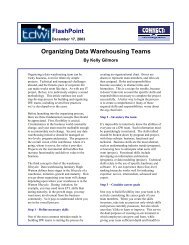
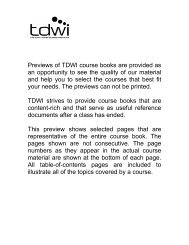

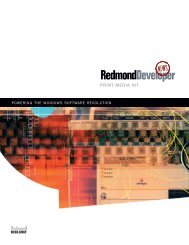


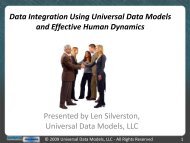
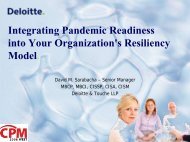
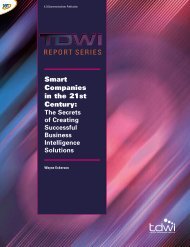
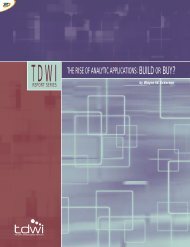
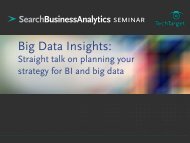
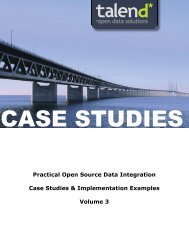
![Ink Jet Formulation- The Art of Color Chemistry 2005 [Read-Only]](https://img.yumpu.com/42062450/1/190x143/ink-jet-formulation-the-art-of-color-chemistry-2005-read-only.jpg?quality=85)
